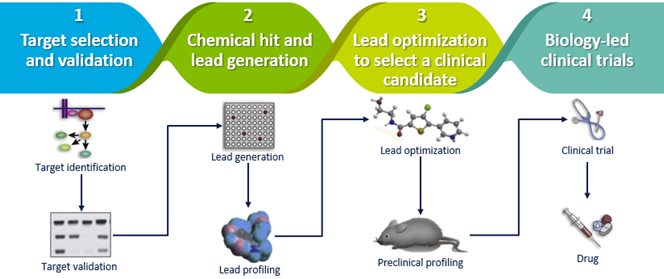SMALL MOLECULES
Therapeutic Potential
Small molecule drugs are able to pass across cell membranes and reach targets in the cell.2
Scientists have created a variety of novel small molecules ranging from enzyme inhibitors to compounds that block the interactions of critical proteins involved in tumor progression.
Pharmacological research in this area often focuses on approaches to restore the cancer cell's ability to die, including:
- PARP1 and PARP2 are naturally occurring enzymes critical to the repair of single-strand DNA breaks. Inhibition of PARP 1 and 2, may lead to accumulation of single- and double-strand DNA breaks in tumor cells that may have limited capacity for DNA repair or are exposed to DNA-damaging agents, resulting in apoptosis.3-5
- PARP activity has also been implicated in pathways that regulate gene expression, such as effects on chromatin structure, transcriptional activator and coactivator functions, and affecting DNA methylation patterns.5
- The BET family (BRD2, BRD3, BRD4, and BRDT) are bromdomain-containing proteins that interact with acetylated histone tails and play important roles in transcription regulation, while inhibition of BET has been shown to induce apoptosis.6,7
Relevant Targets
- Hoelder S, et al. Discovery of small molecule cancer drugs: successes, challenges and opportunities. Mol Oncol. 2012;6(2):155-76.
- Yang NJ, Hinner MJ. Getting across the cell membrane: an overview for small molecules, peptides, and proteins. Methods Mol Biol. 2015;1266:29–53.
- Donawho CK, et al. ABT-888, an orally active poly(ADP-ribose) polymerase inhibitor that potentiates DNA-damaging agents in preclinical tumor models. Clin Cancer Res. 2007;13(9):2728-2737.
- Palma JP, et al. ABT-888 confers broad in vivo activity in combination with temozolomide in diverse tumors. Clin Cancer Res. 2009;15(23):7277-7290.
- Plummer ER, et al. Targeting poly(ADP-ribose) polymerase: a two-armed strategy for cancer therapy. Clin Cancer Res. 2007;13(21):6252-6256.
- Xu Y, Vakoc CR. Targeting cancer cells with BET bromodomain inhibitors. Cold Spring Harb Perspect Med. 2017;7(7).
- Delmore JE, Issa GC, Lemieux ME, et al. BET bromodomain inhibition as a therapeutic strategy to target c-Myc. Cell. 2011;146(6):904-917.


